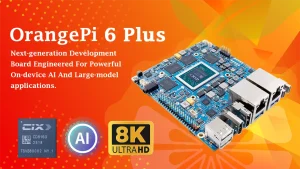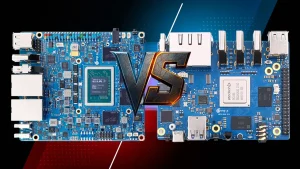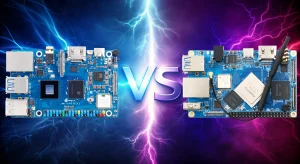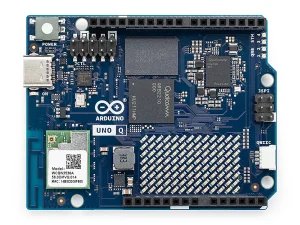
Arduino and Raspberry Pi are among the most popular development boards today, each with unique advantages and specific use cases. While Arduino excels at simple microcontroller-based tasks, Raspberry Pi offers a compact, powerful single-board computer for more complex projects. Understanding the differences in Arduino vs Raspberry Pi, along with their latest models and applications, can help developers, hobbyists, and engineers choose the right board for their project needs, whether it’s for robotics, IoT, home automation, or personal computing. If you are new see Raspberry Pi vs Arduino? Key Differences for Beginners. Want to know which board fits your project best? Keep reading to find out!
Arduino Boards
1. Arduino Uno R4
- Microcontroller: 32-bit ARM Cortex-M4
- Key Features: 14 digital I/O pins, 6 analog inputs, USB connection, and an easy-to-use software IDE.
- Application Areas:
- Beginner-level robotics
- Home automation
- Sensor interfacing
- LED control
2. Arduino Mega 2560
- Microcontroller: ATmega2560
- Key Features: 54 digital I/O pins, 16 analog inputs, and more memory for larger projects.
- Application Areas:
- Large-scale robotics
- Automation systems
- 3D printers
3. Arduino Nano 33 IoT
- Microcontroller: SAMD21 Cortex-M0+ 32-bit ARM
- Key Features: Integrated Wi-Fi, Bluetooth, and an accelerometer.
- Application Areas:
- IoT devices
- Wireless sensor networks
- Wearables
Raspberry Pi Boards
1. Raspberry Pi 4 Model B
- Processor: Quad-core ARM Cortex-A72 64-bit
- Key Features: 2GB, 4GB, or 8GB RAM options, USB ports, HDMI, and GPIO pins.
- Application Areas:
- Full-fledged computing (personal computer)
- Home automation with advanced features
- Media centers (e.g., Kodi, Plex)
- Networking and IoT applications
2. Raspberry Pi Zero 2 W
- Processor: Quad-core ARM Cortex-A53
- Key Features: Smaller form factor, Wi-Fi and Bluetooth connectivity, low power consumption.
- Application Areas:
- Low-cost IoT devices
- Portable systems
- Retro gaming consoles
3. Raspberry Pi Pico
- Microcontroller: RP2040 (dual-core ARM Cortex-M0+)
- Key Features: GPIO pins, 26 multi-function pins, USB, and I2C, SPI, and UART communication.
- Application Areas:
- Embedded systems
- DIY projects
- Sensor-based applications
Comparing Key Differences and Uses of Arduino and Raspberry Pi
When comparing Arduino vs Raspberry Pi, it’s essential to understand their core differences. Arduino is ideal for simple microcontroller tasks, while Raspberry Pi is a powerful single-board computer for more advanced projects, To see complete information about Raspberry Pi, see Wikipedia. it is crucial to know their use cases:
Processing Power
- Arduino: Designed for simple, low-power microcontroller tasks. It operates without an operating system, executing a single program at a time.
-
Raspberry Pi: Functions as a full computer, running Linux or other OS, capable of handling multitasking and more complex applications.
Arduino Uses vs Raspberry Pi Uses
- Arduino Uses:
- Controlling sensors and actuators
- Real-time automation
- Robotics
- Low-power embedded systems
- Raspberry Pi Uses:
- Media centers and servers
- IoT applications with networking
- Personal computing and software development
- AI and machine learning applications
Flexibility and Connectivity
- Arduino: Limited in terms of connectivity (Wi-Fi and Bluetooth available only on specific models like Nano 33 IoT).
- Raspberry Pi: Supports advanced networking options, USB ports, HDMI, and GPIO for interfacing with other hardware.
Power Consumption
- Arduino: Extremely low power consumption, ideal for battery-powered projects.
See Low Power Design Guide for Arduino
- Raspberry Pi: Higher power consumption, requiring a stable power source.
Cost and Affordability
- Arduino: Generally more affordable, making it a cost-effective choice for simple projects.
- Raspberry Pi: More expensive but offers greater computational capabilities.
Arduino or Raspberry Pi: Which One Should You Choose?
Choosing between Arduino and Raspberry Pi depends on the project requirements. If real-time control, simplicity, and energy efficiency are priorities, Arduino is the better choice. If computational power, multitasking, and OS-based functionality are needed, Raspberry Pi is the superior option.
Comparison Table: Latest Arduino and Raspberry Pi Boards
| Feature | Arduino Uno R4 | Arduino Mega 2560 | Arduino Nano 33 IoT | Raspberry Pi 4 Model B | Raspberry Pi Zero 2 W | Raspberry Pi Pico |
|---|---|---|---|---|---|---|
| Microcontroller/Processor | ARM Cortex-M4 32-bit | ATmega2560 | SAMD21 Cortex-M0+ 32-bit ARM | ARM Cortex-A72 64-bit quad-core | ARM Cortex-A53 quad-core | RP2040 (ARM Cortex-M0+ dual-core) |
| Memory | 32KB SRAM, 256KB Flash | 8KB SRAM, 256KB Flash | 256KB Flash, 32KB SRAM | 2GB, 4GB, or 8GB RAM | 512MB RAM | 264KB RAM |
| Digital I/O Pins | 14 pins | 54 pins | 14 pins | 26 GPIO pins | 40 GPIO pins | 26 GPIO pins |
| Analog Pins | 6 pins | 16 pins | 7 pins | 4 analog pins | 1 analog pin | 3 analog pins |
| Network Connectivity | None | None | Wi-Fi and Bluetooth built-in | Wi-Fi and Bluetooth built-in | Wi-Fi and Bluetooth built-in | None |
| Special Features | Easiest board for beginner projects | More memory and pins for larger projects | Suitable for IoT and wearable devices | Suitable for personal computing and complex projects | Low-cost, ideal for portable systems | Suitable for embedded and DIY projects |
| Application Areas | Beginner robotics, home automation, LED control | Large-scale robotics, automation, 3D printers | IoT, wireless sensor networks, wearables | Personal computer, advanced home automation, media | Low-cost IoT devices, portable systems | Embedded systems, DIY projects, basic sensors |
| Approximate Price | Affordable | Relatively affordable | Affordable | More expensive than Arduino | Very affordable | Affordable |
This table summarizes the features and application areas of Arduino and Raspberry Pi boards to help you make an informed choice based on your project requirements.
Conclusion
Both Arduino and Raspberry Pi have their unique advantages, applications, and differences. While Arduino excels in simplicity, real-time control, and low-power applications, Raspberry Pi dominates in computational tasks, networking, and multimedia applications. The choice between Arduino or Raspberry Pi depends on the project’s complexity and requirements.
We hope this comparison has helped clarify which board suits your needs best. Have you used Arduino and Raspberry Pi in your projects? Share your experiences and opinions in the comments below!
FAQ
Which is better for robotics, Arduino or Raspberry Pi?
Arduino is better for real-time control and simple robotics tasks.
Can Arduino and Raspberry Pi be used together in a project?
Yes, Arduino and Raspberry Pi can be combined in a project; Raspberry Pi handles advanced processing tasks, while Arduino manages hardware control and simple applications.
Suggested content:
Latest Arduino Projects and Raspberry Pi Innovations for 2025






5 thoughts on “Comparison of the Latest Arduino and Raspberry Pi Models and Their Applications”
Pingback: Top New Arduino Projects and Raspberry Pi Ideas for 2025
Pingback: Raspberry Pi vs Arduino: 4 Differences for Beginners
Pingback: Latest Arduino Boards 2025: Top 5 Products for IoT & Gadgets
Pingback: Raspberry Pi 6 : New Features and What You Need to Know
Pingback: Servo Motors VS Stepper Motors: Essential Technical Comparison